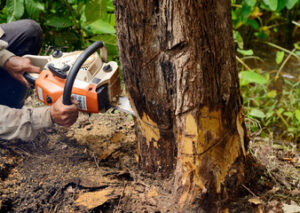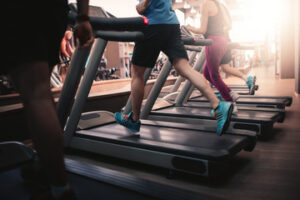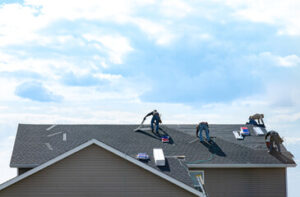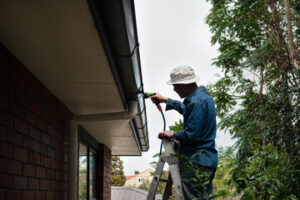Tree Service Irvine features a team of certified arborists who undergo rigorous education & training. Their expertise extends to understanding different trees & their growth patterns – as well as diagnosing problems. They are also backed by licensure, specialized equipment & insurance.

Tree pruning shapes landscapes, enhancing aesthetics and contributing to property value. It also eliminates dead, diseased or weak branches, and thins limbs to promote new growth & sunlight penetration.
The safety of property and people is a key concern when performing tree service. Branches that overhang walkways, houses or power lines need to be carefully trimmed and handled with precision to avoid hazards. Tree services can also mitigate potential damage by inspecting and treating trees for pests, diseases and structural problems.
A safety assessment should be performed before beginning work on a tree, including visually inspecting the equipment and the surrounding environment. In addition, weather conditions must be taken into consideration, as they may affect the safety and performance of the work being done. For example, if it is windy or raining the arborists might not be able to safely climb or trim a tree.
In addition to proper training, a reputable and experienced tree service will take steps to ensure the safety of their employees and the public. This includes securing necessary permits, setting up safety barriers, and notifying nearby properties if needed. It is also important to have an emergency response plan, in case of a tree failure or accident during the course of a job.
Trees add beauty and value to a property, but they can be dangerous without proper care. When trees are neglected, they can become tangled in branches and fall unpredictably. When a tree fails, it can cause injuries to people and property damage. Regular tree services are an effective way to keep trees healthy and safe while maintaining a pleasing aesthetic.
Choosing the right tree service is essential for your home or business. Look for a company with a solid reputation, strong referrals and certifications from reputable trade associations. They should be able to clearly explain their procedures and provide you with an estimate before starting any work. In addition, they should have comprehensive insurance coverage that protects you from liability in the event of an accident or damage to your property.
To help prevent accidents, it is recommended that you use a chainsaw with a guard, and wear personal protective equipment (PPE) such as a hard hat, goggles, hearing protection, fluorescent vest, cut-resistant trousers and safety boots. It is also a good idea to have a partner when trimming or felling a tree. This will allow you to keep a close eye on the direction of falling branches and can help prevent falls.
Health
When a tree health diagnosis is performed, the expert arborist will take into account factors beyond a trees’s control such as the surrounding soil conditions and the trees location to identify any external issues that could impact its vitality. They will then determine if the tree requires treatment or maintenance to support its growth and enhance its health. This may include pruning, fertilization or other treatments.
In addition to assessing the overall condition of the trees, they will inspect for signs of disease or pest infestation. This includes examining the trunk and roots for any signs of disease, compression or decay as well as assessing the root spread and the size of the roots. An inspection for girdling roots (where the roots encircle or choke the trunk) is also important, as this can lead to weakening of the structure of a tree and can cause it to lean or become unstable.
Aside from identifying the potential for a particular issue, routine assessments can help homeowners save money by preventing costly repairs and replacements. For instance, a tree that has been compromised by disease or pests can drain the soil of nutrients, leaving other healthy trees with very few resources to draw from. An inspector can identify these diseases and perform preventative measures to stop them from spreading, thereby protecting the health of other trees in the landscape.
Keeping the trees on your property looking their best not only improves curb appeal, but can also increase its value. In addition to the aesthetic benefits, trees provide timber, paper and shelter for wildlife and help replenish the environment with oxygen, filter pollution and provide shade and sound barriers. Many homeowners are recognizing the importance of maintaining their trees, which is leading to increased interest in tree service.
When choosing a Tree Service, it is crucial to choose a company with an experienced team of ISA certified arborists and specialized equipment. This type of specialized machinery is often not found in the back of a DIYer’s truck and can make all the difference in a job done well. Additionally, a service that is licensed and insured will ensure that all work is conducted under professional standards, providing you with peace of mind that any unforeseeable accidents or damage to your property will be covered.
Aesthetics
Professional tree service providers are well-versed in aesthetics, ensuring that trees are pruned and maintained in a way that promotes health and longevity. They have the knowledge and expertise to prune trees in a manner that enhances their overall beauty, while also improving air circulation and sunlight exposure. Moreover, they understand how to balance this with the safety of structures and people below them.
The aesthetics measures taken by Tree Service professionals are not just limited to pruning and trimming, but include a wide variety of other activities, such as stump grinding and removal, tree planting, pest management, and soil fertilization. In addition, they are trained in the identification of a range of structural problems, such as weak branches and shallow root systems, that can compromise the integrity of a tree.
Aside from enhancing the appearance of a property, the services provided by professional arborists can also help prevent damage to property during storms and high winds. Overgrown trees and branches can easily fall, posing a risk to buildings or vehicles on the premises. In addition, they can damage utility lines, which is costly to repair. By conducting regular inspections, Tree Service professionals can identify and address potential hazards before they occur.
Additionally, a landscape with well-maintained trees contributes to the value of the commercial property. Aesthetically pleasing trees are a key factor in attracting prospective buyers or tenants, and they offer a sense of sophistication that elevates the ambiance of a space.
As a result, it is essential for property owners to understand the importance of maintaining an attractive and functional landscape. Aside from boosting curb appeal and fostering an inviting atmosphere, the trees on a property serve as natural air filters that promote environmental sustainability. In addition to reducing pollution, they help sustain local ecosystems by providing shade that conserves energy and releasing oxygen, while also serving as habitats for wildlife species.
Value
Trees play an essential role in our ecosystem, providing shade, oxygen, and biodiversity. They are also a source of aesthetic value, and well-maintained trees increase property values and provide a sense of enchantment. However, they require specialized knowledge and equipment to maintain health, safety, and visual appeal. Homeowners and businesses looking for professional Tree Service are seeking to proactively address arboreal concerns, rather than reacting after damage or disease has occurred. As a result, they are willing to pay for the expertise of a knowledgeable, reliable tree care company to ensure that their investments stay vibrant and healthy.
The value of a well-maintained yard and landscape is often underestimated, but it can impact the overall appearance and curb appeal of homes and commercial properties. In fact, curb appeal is one of the first impressions that passersby and visitors have of a business or residential space, making it important to create a positive first impression. Proper tree care can boost curb appeal by maintaining the beauty of existing trees and preventing the growth of unhealthy, dangerous, or unsightly plants.
In addition, a well-maintained yard can make a business more attractive to potential customers and employees. Keeping shrubs and other plants neatly trimmed and displaying colorful blooms will reinforce the image of a clean, well-kept environment. In turn, this can help boost sales and increase brand recognition.
A growing number of homeowners are recognizing the importance of maintaining the integrity and value of their outdoor spaces. As a result, they are seeking tree services to ensure that their outdoor investments remain healthy and beautiful for years to come.
When choosing a tree service provider, look for one with a strong track record of customer satisfaction and excellent safety practices. Ask what education and training their team members have received, as well as what certifications they hold. Additionally, check if they have a local presence and deep connections in the community.
The cost of tree services will vary depending on the type and complexity of work performed. For example, large trees will require a more labor-intensive approach, which can drive up the price of services. To avoid surprises, choose a company that offers transparent, clear pricing. This strategy allows clients to understand what factors are influencing the cost of a particular project and provides peace of mind that they will not be overcharged.


